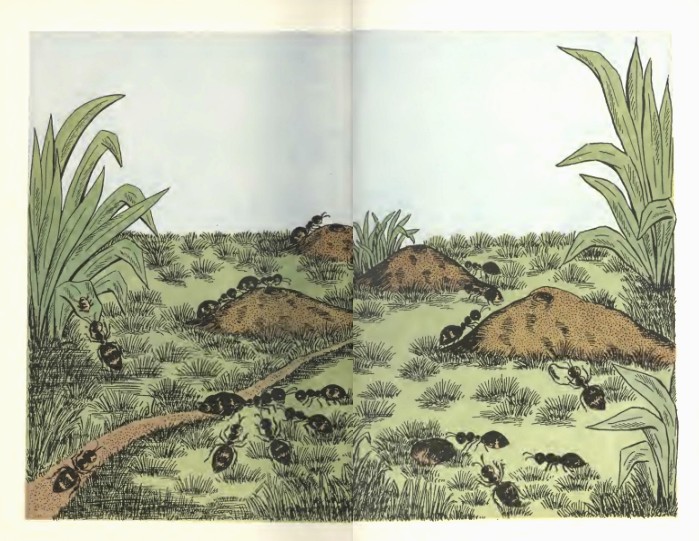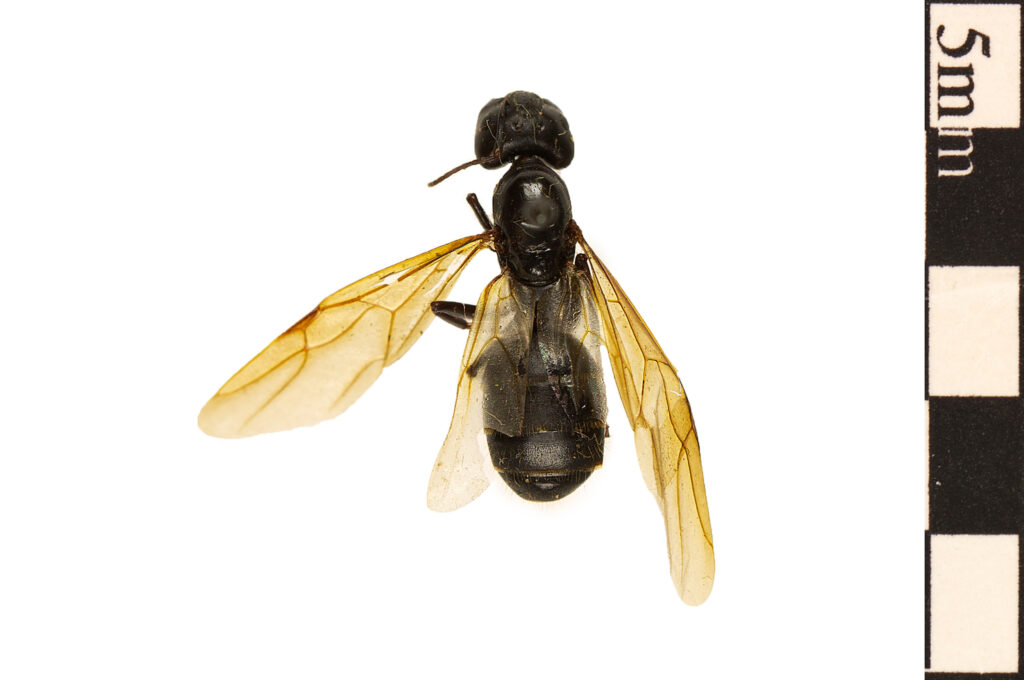The Ant
By Willis and Rand [1]
Annotations by Jessica Abell

In eastern countries, Ants build their nests the height of from six to twelve feet, which is curiously formed, with numerous apartments and passages, consisting of regular walls and ceilings; these are made of bits of wood, sand, earth, and gum, and are usually built near some large tree and a stream of water. The body of the black ant is divided into head, breast, and belly. In its head are observed its eyes, under which are two small horns, or feelers, each composed of twelve joints, all covered with very fine silky hair. The mouth has two crooked jaws, in each of which there appear to be teeth. From the breast project six legs, each armed with two small claws. The Ants, like the Bees, are divided into three classes of males, females, and neutrals. The females are the largest, and the working tribe, or neutrals, are the smallest. The males and females have wings, which they sometimes lose.
So soon as the winter is past, these insects make their appearance, and the Ant-hill swarms with new life. On the first day they never leave home, but appear running about in all directions over the hill, as if to examine its condition, and to observe what repairs it may require. They then go to work with surprising activity to set all right, and pass the summer either in the employment of repairing their houses, or laying in a stick of food. It is a very curious sight to notice the laborious manner in which the bring various things home. If they meet with any thing too heavy for one to carry, several will assist, some dragging, others pushing; and thus in time they convey it home.
The fond attachment that the Ants have for their young is remarkable. In cold weather they take them in their mouths down to the bottom of their habitations, where they are less subject to the severity of the season. In a few days they remove them with the same care, nearer the surface, where they may be cheered with the warm beams of the sun.
At the slightest alarm, the Ants will sally out upon whatever disturbs them, and if they have time to stop their enemy, they show him no mercy. Sheep, Hens, and Rats, are often stung to death by multitudes of these merciless insects, and the flesh devoured to the bone. No anatomist in the world can strip a skeleton so clean as they; and no animal, however strong, when they have once seized upon him in sufficient numbers has power to resist them.
Anecdote.–In Africa, Ants are exceedingly numerous. Mr. Smith says, that during his residence at Cape Coast Castle, a body of these strange visitors came to the fortification. It was about day-break when the foremost part of them entered the chapel where some negro servants were sleeping. The men were quickly alarmed at the invasion of this unexpected army, and prepared as well as they could for their defence.–While the foremost battalion of these insects had already taken possession of the place, the rear-guard was more than a quarter of a mile distant. The while ground seemed alive and crawling with unceasing destruction. After considering a few minutes what was to be done, it was resolved to lay a large train of gun-powder along the path they had taken: by this means millions were blown to pieces, and the rear-guard perceiving the destruction of their leaders, thought proper to retire back to their original habitation.
Scripture References.–The few references that are made in Scripture to the Ant are of the considerable interest, , as they convey some important instructions. This active little insect is presented to our attention as a pattern of commendable saving, and increasing industry. Agur calls them exceedingly wise, and says of them, “The Ants are a people not strong, yet they prepare their meet in summer.”–Proverbs xxx: 25. He therefore sends the sluggard to them to learn wisdom, foresight, care, and diligence. The admirable order and harmony which prevail in their society, the amazing care with which they lay up their food, the unwearied industry and activity with which they pursue their work, and the prompt manner in which they run to lend their most friendly assistance to each other, all afford so many striking examples to mankind, that the Ant, though a most feeble creature in its nature, and most humble as it respects its station is yet well worthy to be regarded as a useful instructor of the human race, especially that part of them who mispend their time in improvident speculations, or wilful idleness, “Go to the Ant, thou sluggard, consider her ways, and be wise; which having no guide, overseer, or ruler, provideth her meat in the summer, and gathereth her food in the harvest.” Proverbs vi: 6. The skill, the vigour, the amazing activity, which the little Ants display in digging under ground, in building their houses, in forming their apartments, in filling their granaries with corn for the winter, in forming channels to carry off the rain, and in brining forth their hidden stores that are in danger of being spoiled by moisture, and exposing them to dry by the sun and air, all afford many most useful lessons.–How much reason then had Solomon to point to its shining example as worthy of imitation, and how much reason also have teachers now to address their scholars and say, “Go thou and do likewise,” that ye may not only become learned in notion, but wise in practice.
Reflections.–To be wise, provident, and, and diligent in the affairs of this life if of much importance.–It is better to labour advantageously, like the Ant, than to skip abroad and take pleasure in the sunshine, like the Grasshopper[2]. The former has a store laid by to preserve its life in the winter: but the latter perishes when the sever weather comes.
It is, however, of a far greater importance that we should become wise into salvation, through faith which is in Christ Jesus, and lay up durable riches while the season of mercy continues. We are commanded to “work out our own salvation with fear and trembling,” and thus, by the blessing of God, provide for a state of never-ending duration.

Writers’ program. Pennsylvania. Life in an Ant Hill,. Chicago, A. Whitman & co., 1940. Internet Archive, http://archive.org/details/lifeinanthill00writ.
Willis and Rand. “The Ant.” Youth’s Companion, vol. 2, no. 2, June 1828, p. 3.
“Black Carpenter Ant.” Smithsonian Institution, https://www.si.edu/object/black-carpenter-ant%3Anmnheducation_10002840. Accessed 9 Nov. 2020.
[1] Nathaniel Willis and Asa Rand were the publishers of Youth’s Companion and are the likely authors of “The Ant.”
[2] Willis and Rand are referring to Aesop’s fable “The Ant and the Grasshopper.”
Contexts
Youth’s Companion is a weekly turned monthly children’s periodical that ran from 1827-1929. It began as a Sunday School companion.
Resources for Further Study
- The Life of North American Insects by B. Jaeger.
- Published in 1859
Pedagogy
- For more information about ants visit: Pest World for Kids
- Have you observed ants acting in the manner described in the article?
- What kinds of different ants are there?